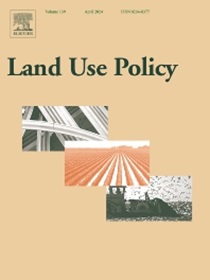农民资源、能力和观念对大西洋森林再造林和森林覆盖的作用
IF 6
1区 社会学
Q1 ENVIRONMENTAL STUDIES
引用次数: 0
摘要
在联合国生态系统恢复十年(2021-2030)的背景下,迫切需要深入了解如何让土地使用者参与再造林工作。本研究考察了土地使用者(即农民)在巴西大西洋森林(BAF)重新造林方面的资源、能力和观点,该生态区拥有巴西70% %的人口,同时也是生物多样性热点,仅保留28% %的原生植被覆盖。78 这个生态区的领土中有80%是农村私有财产,这表明了农场森林恢复的重要性。我们研究了森林覆盖变化如何通过农民对激励因素的看法(如亲自然态度)和农民参与再造林的资源和能力来解释的途径。数据是通过一项涉及257名农民及其财产和森林覆盖的定量调查收集的,这些调查来自地理空间图像。使用基于路径分析的多元回归模型,我们发现农民对森林覆盖的积极和消极看法的影响很小且不显著,但结合农民的资源和能力,这些模型可以解释高达36% %的森林覆盖变化。在排除和包括农民感知的模型中,作为生产适宜性代表的能力“坡度”和作为可用资本代表的资源“农场规模”始终与森林覆盖高度正相关。这些结果突出表明,农民的再造林决策是复杂的,应加以相应的评价,因为它不仅考虑到对森林本身的认识,而且还考虑到现有的恢复资源和能力。考虑到本研究中评估的变量,森林保护和恢复举措可以受益;资源、能力和对激励和亲自然动机的看法,而潜在的解决办法,如积极的政策机制,需要考虑土地的异质性和不同类型的土地所有者。本文章由计算机程序翻译,如有差异,请以英文原文为准。
The role of farmer’s resources, capabilities and perceptions on reforestation and forest cover in the Atlantic Forest
In the context of the UN Decade of Ecosystem Restoration (2021–2030), insights are urgently needed on how to engage land users in reforestation efforts. This study examined the resources, capabilities and perspectives of land users, i.e., farmers, in relation to reforestation in the Brazilian Atlantic Forest (BAF), an ecoregion that hosts 70 % of the Brazilian population while is also a biodiversity hotspot with only 28 % of native vegetation cover remaining. 78 % of the territory of this ecoregion is occupied by rural private properties, indicating the importance of on-farm forest restoration. We studied the pathways of how variation in forest cover can be explained by farmers’ perceptions of incentives, like pro-nature attitudes, and farmers’ resources and capabilities to engage in reforestation. Data were collected through a quantitative survey involving 257 farmers and their properties and forest cover derived from geo-spatial imagery. Using multiple regression models that underlie a path analysis, we found small and non-significant effects of both positive and negative perceptions of farmers on forest cover, but in combination with farmers’ resources and capabilities, these models could explain up to 36 % of variation on forest cover. The capability “slope”, as a proxy for production suitability, and the resource “farm size”, as a proxy for available capital, were always highly positively associated with forest cover in the models excluding and including farmers’ perceptions. These results highlight that reforestation decision making of farmers is complex and should be assessed accordingly, since it does not only regard the perceptions of the forest itself, but also the available resources and capabilities for restoration. Forest conservation and restoration initiatives can benefit from considering the variables assessed in this study; resources, capabilities, and perceptions of incentives and pro-nature motivation, while potential solutions, such as positive policy mechanisms, need to consider the heterogeneity of land and different types of landowners.
求助全文
通过发布文献求助,成功后即可免费获取论文全文。
去求助
来源期刊

Land Use Policy
ENVIRONMENTAL STUDIES-
CiteScore
13.70
自引率
8.50%
发文量
553
期刊介绍:
Land Use Policy is an international and interdisciplinary journal concerned with the social, economic, political, legal, physical and planning aspects of urban and rural land use.
Land Use Policy examines issues in geography, agriculture, forestry, irrigation, environmental conservation, housing, urban development and transport in both developed and developing countries through major refereed articles and shorter viewpoint pieces.
 求助内容:
求助内容: 应助结果提醒方式:
应助结果提醒方式:


